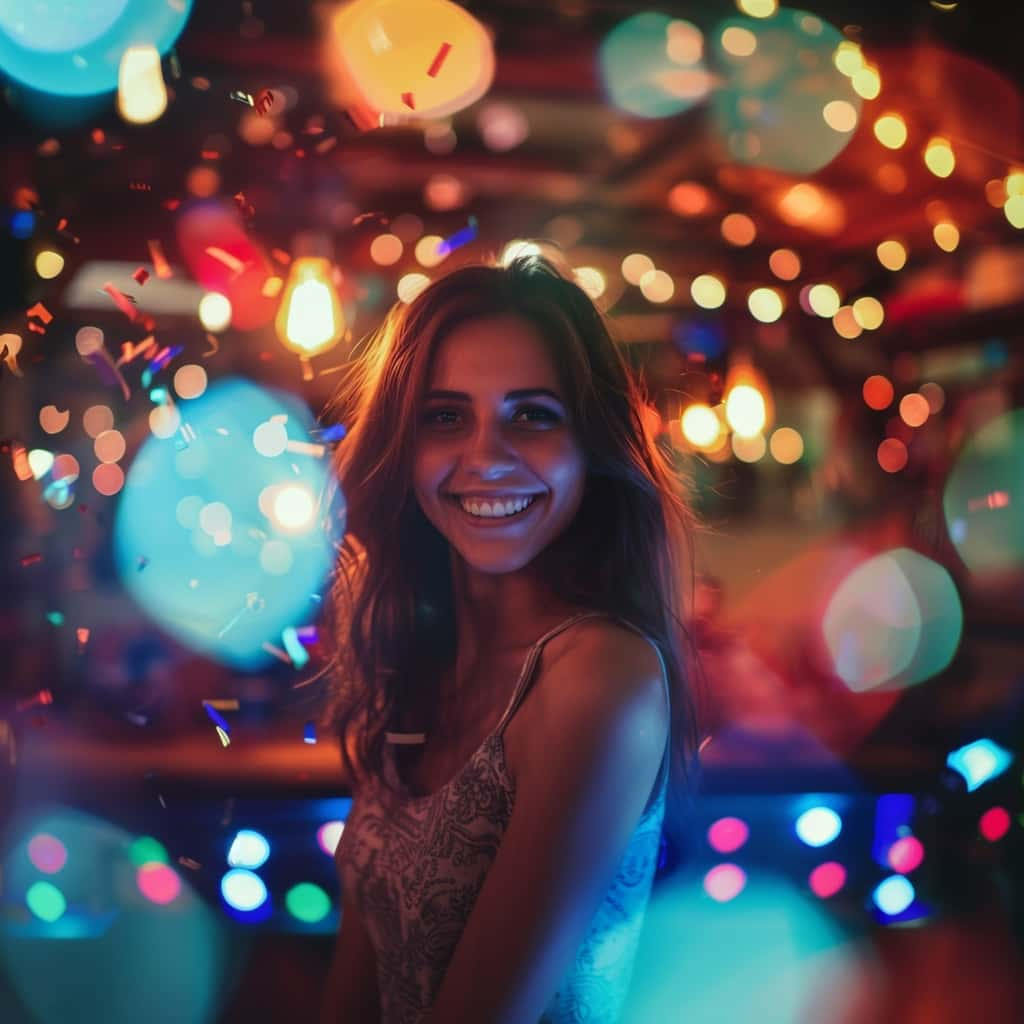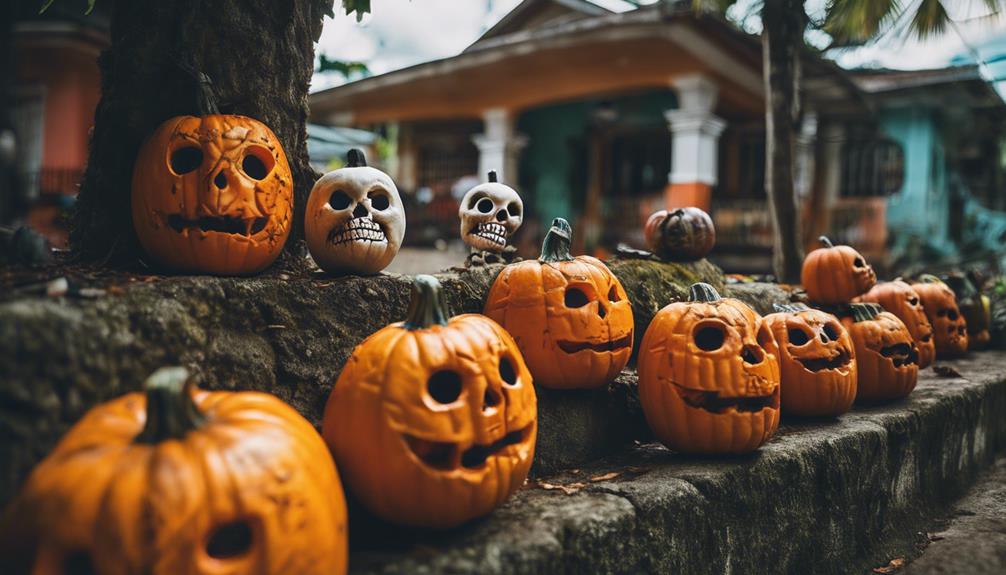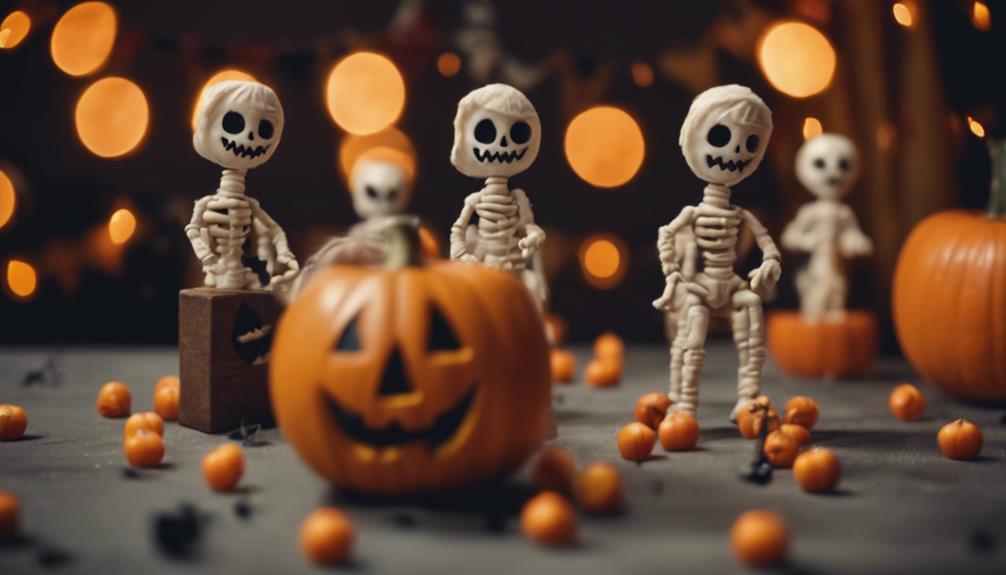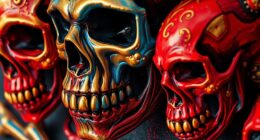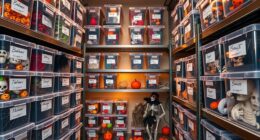When you think about Halloween costumes, cultural options add unique flair and meaning. Witch costumes trace back to the Middle Ages, embodying both fear and empowerment. Vampire costumes, influenced by Eastern European legends, reflect societal anxieties. Mummy costumes celebrate ancient Egyptian practices, merging horror with humor. Samurai outfits showcase Japan's rich heritage, highlighting honor and artistry. Pirate costumes evoke adventure and rebellion, while ghost ensembles connect to ancient beliefs about spirits. Each choice has a story worth exploring. If you're curious about more cultural inspirations behind these costumes, there's plenty more to discover!
Key Takeaways
- Historical costumes like witches and mummies reflect ancient superstitions and cultural practices tied to festivals like Samhain.
- Mythical figures such as vampires and werewolves symbolize societal fears and connect to folklore about transformation and the supernatural.
- Literary inspirations, including Frankenstein's Monster and Alice in Wonderland, showcase characters that resonate with themes of creation, curiosity, and imagination.
- Cultural representations like samurai and pharaoh costumes celebrate historical significance and artistry, connecting modern celebrations to rich traditions.
- Pop culture costumes, such as pirates and superheroes, are driven by films and media, embodying themes of adventure, empowerment, and resilience.
Witch Costumes and Their History

Witch costumes are often a staple of Halloween celebrations, drawing on a rich history that dates back to the Middle Ages. During this time, the perception of witches was heavily influenced by superstition and fear, often depicting them as old women with pointed hats and broomsticks. This portrayal connected deeply with the history of Halloween, particularly through the Celtic festival of Samhain, where it was believed that witches could interact with spirits as the veil between the living and the dead thinned.
As Halloween evolved into a more festive occasion in the 19th century, so did the image of witches. They shifted from ominous figures to more playful and whimsical characters.
In the 20th century, especially during the 1960s and 1970s, witch costumes surged in popularity, as feminist movements embraced the witch as a symbol of empowerment and independence.
Today, witch costumes remain a top choice for Halloween, blending traditional elements with contemporary styles. You'll often see them featuring influences from popular culture, showcasing characters from movies and television.
Vampire Costumes: Myth and Culture

When you think about vampire costumes, you can't ignore their deep roots in Eastern European legends and the way they've evolved over time.
From the chilling tales of reanimated corpses to the glamorous figures in today's media, vampires have captured our imagination for generations.
This blend of historical myth and modern allure keeps vampire costumes a favorite choice for Halloween celebrations.
Historical Vampire Legends
Throughout history, people have been captivated by the legends of vampires, with tales of blood-drinking entities emerging from ancient civilizations like Mesopotamia, Greece, and Rome. These vampire legends often reflect societal fears, particularly concerning the dead rising and immortality. The modern vampire mythos, shaped by 18th-century Eastern European folklore, brought the iconic figure of Count Dracula to life, especially through Bram Stoker's 1897 novel.
As you explore the cultural significance of these legends, you'll notice how they've influenced Halloween costumes. The image of the vampire has transformed over the years, from terrifying monsters to romantic figures. Here's a quick overview of key elements:
| Element | Description | Cultural Reference |
|---|---|---|
| Capes | Symbol of mystery and allure | Common in classic vampire films |
| Fangs | Iconic representation of vampirism | Associated with blood-drinking |
| Pale Makeup | Evokes the undead aesthetic | Used in various Halloween costumes |
| Seductive Appeal | Reflects societal anxieties | Seen in modern vampire portrayals |
These components continue to shape Halloween costumes today, inviting people to engage with the rich tapestry of vampire lore.
Modern Vampire Popularity
Vampire costumes have become a staple of Halloween celebrations, seamlessly blending myth with modern culture. Drawing on centuries of folklore, they often reference figures like Dracula, popularized by Bram Stoker's 1897 novel. This character's allure taps into themes of immortality and seduction, making vampire costumes a favorite choice for festive occasions.
The psychological appeal of these costumes can also be linked to understanding emotional dysregulation, as they allow individuals to explore their fears and desires in a safe and playful environment.
Since the 1970s, the rise of horror films and television shows, particularly "Buffy the Vampire Slayer," has fueled the popularity of vampire-themed costumes. These portrayals reflect societal fears and desires, symbolizing cultural anxieties about death, sexuality, and the unknown. This depth adds an intriguing layer to your Halloween attire.
Today, vampire costumes have evolved to include various styles, from traditional caped figures to modern interpretations influenced by pop culture. Whether you prefer a classic look or a contemporary twist, there's a vampire costume that fits your taste.
The versatility of these costumes allows you to express your unique style while engaging with the rich history and mythology of vampires. So, as you prepare for Halloween, consider how a vampire costume can connect you with centuries of cultural storytelling.
Mummy Costumes: Origins in Egypt

Mummy costumes have captivated imaginations for centuries, tracing their roots back to ancient Egypt's rich traditions. In ancient times, the practice of mummification was central to Egyptian beliefs about immortality and the afterlife. They wrapped the deceased in linen, creating the iconic mummy wrap you see today. This was done to prevent decay and protect the body for its journey into the afterlife.
Fast forward to modern Halloween celebrations, and you'll notice how mummy costumes have evolved. Today, they come in various forms, from authentic representations to playful, spooky interpretations featuring tattered clothing and exaggerated makeup.
The fascination with mummies surged during the 19th and 20th centuries, thanks to films and stories that cemented the mummy as a classic Halloween figure.
Now, mummy costumes embody both horror and humor, making them a favorite choice for parties and trick-or-treating. Whether you opt for a creepy look or a fun twist, these costumes offer a unique way to connect with ancient Egyptian culture while enjoying the spirit of Halloween.
Samurai Costumes: Japanese Heritage

When you think of samurai costumes, you're likely envisioning the striking attire of Japan's noble warrior class, steeped in history and tradition.
Originating in the 12th century, samurai were more than skilled fighters; they embodied the code of bushido, emphasizing honor, discipline, and loyalty. Their costumes reflect this heritage, showcasing intricate designs that tell stories about their clan and rank.
Here are three key elements of samurai costumes that highlight their cultural significance:
- Ornate Armor: Samurai armor, with its layered construction and distinctive patterns, wasn't just protective gear but also a display of artistry and status.
- Katana: The iconic katana symbolizes the samurai's martial prowess and is often a central feature of their costumes, representing their skill and honor in battle.
- Hairstyles: Traditional hairstyles, like the topknot (chonmage), are integral to samurai costumes, signifying both cultural identity and rank.
Today, samurai costumes are celebrated in modern culture through films and anime, making them a popular choice for Halloween, connecting wearers to the rich tapestry of Japanese heritage.
Pirate Costumes: Legends of the Sea

While samurai costumes evoke images of disciplined warriors, pirate costumes whisk you away to the adventurous domains of the high seas. Rooted in the swashbuckling figures of the 17th and 18th centuries, these costumes embody the spirit of rebellion and adventure. Popularized by films like "Pirates of the Caribbean," they've become a Halloween tradition, appealing to all ages.
Imagine donning a classic pirate outfit, complete with a tricorn hat and eye patch, as you set sail on your Halloween adventure. Here's a glimpse into the iconic elements of your pirate persona:
| Element | Description | Symbolism |
|---|---|---|
| Tricorn Hat | A wide-brimmed hat worn by pirates | Adventure and freedom |
| Striped Shirt | Classic shirt style, often in bold colors | Nautical heritage |
| Toy Sword | A playful representation of a cutlass | Bravery and swashbuckling |
With roots tracing back to the 1920s, pirate costumes continue to evolve, blending fantasy and cultural heritage. So this Halloween, embrace the thrill of the sea and transform into a legendary pirate!
Ghost Costumes: Folklore and Fear

When you think about ghost costumes, you're tapping into a rich history of folklore that reflects humanity's fear of the unknown.
These costumes have evolved over time, with the iconic white sheet rooted in ancient funerary customs.
As you explore the significance of these spectral figures, you'll find their role in honoring the dead and embodying cultural beliefs about the afterlife.
Historical Significance of Ghosts
Ghost costumes have deep historical roots, reflecting humanity's complex relationship with death and the afterlife. Traditionally, these costumes symbolize the spirits of the dead, especially during celebrations like Samhain when the boundaries between the living and the dead blur.
This practice reminds us of the historical significance of ghosts in various cultures and their influence on Halloween festivities, much like how certain zodiac signs influence attractiveness and self-image.
Here are three key aspects of ghost costumes and their significance:
- Cultural Representation: In many societies, ghosts embody the fears and beliefs surrounding death, serving as reminders that the deceased may still have a presence in the living world.
- Folklore and Rituals: Medieval Europe utilized ghostly figures in religious plays to highlight the afterlife, reinforcing the idea that the dead could impact the living, shaping community beliefs.
- Simplicity and Universality: The classic white-sheet ghost costume has remained popular due to its simplicity, representing a universal symbol of fear and the supernatural across cultures.
These elements contribute to the enduring appeal of ghost costumes, making them a staple of Halloween celebrations worldwide.
Evolution of Ghost Costumes
Evolving from ancient traditions, ghost costumes have transformed considerably over the centuries, reflecting changing societal fears and beliefs about the afterlife. Originating from the ancient Celtic festival of Samhain, people donned disguises to evade recognition by wandering spirits. Over time, these costumes evolved with cultural influences and interpretations of the supernatural.
In the 19th century, as Halloween grew in popularity in America, ghost costumes became a staple, mirroring societal fascinations with death and the unknown. Literature and film, such as Charles Dickens' "A Christmas Carol," further popularized and shaped the design of these costumes.
Today, modern ghost costumes often blend traditional elements with contemporary horror aesthetics. Let's take a closer look at their evolution:
| Era | Characteristics |
|---|---|
| Ancient Traditions | Ethereal beings, white sheets |
| 19th Century | Reflect societal fears, popularized in America |
| Modern Day | Chains, masks, glowing features |
With each iteration, ghost costumes continue to capture our imagination, reminding us of the deep-rooted folklore and fears that have shaped our views on life and death.
Werewolf Costumes: Shapeshifting Lore

The allure of werewolf costumes taps into a rich tapestry of folklore, where tales of shapeshifting humans transforming into wolves have fascinated cultures for centuries.
Ancient stories from the Greeks and Romans depicted these transformations, often occurring during the full moon. This theme gained traction in the 18th century, particularly in Europe, where werewolves became linked to witch trials and fears surrounding lycanthropy.
Today, when you don a werewolf costume, you're not just dressing up; you're embodying a symbol of humanity's primal instincts.
Here are three key elements that define these costumes:
- Fur: Capturing the creature's wild nature, fur adds an authentic touch.
- Fangs: Sharp, menacing fangs emphasize the fearsome aspect of werewolves.
- Clawed Hands: Claws evoke the power and ferocity associated with these shapeshifting legends.
Clown Costumes: From Joy to Horror

Clown costumes have a fascinating history, starting as symbols of joy in circuses and comedic performances.
Over time, they've transformed into figures of horror, especially influenced by popular media like horror films.
Today, you can choose between traditional, cheerful clowns or their more sinister counterparts, reflecting the complex evolution of clown imagery.
Historical Clown Origins
Throughout history, clown costumes have captivated audiences with their vibrant colors and playful designs, tracing back to ancient theatrical traditions. The "clown" character made its debut in the 16th century through the Italian commedia dell'arte, embodying humor and mischief.
Not only did these historical clowns entertain, but their distinctive outfits also set the stage for modern interpretations, much like how air purifier maintenance guarantees peak performance in our homes.
Here are three significant influences on clown costumes:
- Court Jesters: In the Middle Ages, court jesters wore bright, exaggerated attire, serving as both entertainers and social commentators. Their influence is evident in today's clown designs.
- Commedia dell'arte: These comedic characters utilized masks and vibrant clothing to convey emotions, establishing a foundation for the playful aesthetic of clown costumes.
- Circus Performers: In the 19th century, circus clowns adopted colorful costumes, bringing joy to audiences worldwide and solidifying the clown's role as a beloved entertainer.
Today, while traditional clown costumes still exist, they often reflect a blend of humor and horror, capturing the complex legacy of historical clowns.
Evolution to Horror
As the whimsical charm of traditional clown costumes captured hearts for centuries, societal fears began to reshape their image into something dark and unsettling. Initially, clowns were beloved figures in circuses, embodying joy and entertainment.
However, by the 1970s and 1980s, the evolution to horror started gaining momentum. Films like "It" painted clowns as sinister beings, tapping into deep-rooted anxieties, much like the way characters in Microcosmic Symphony explore diverse interpretations of a central theme.
The popularity of clown costumes surged in the early 20th century, but recent decades have seen a drastic shift. Incidents such as the 2016 clown sightings added fuel to the fire, leading to widespread fear and a decline in traditional clown costumes for Halloween.
Nowadays, even though you may still find exaggerated makeup and colorful attire in some costumes, modern horror-themed versions incorporate more sinister elements, reflecting current societal fears and media portrayals.
This transformation highlights a broader cultural trend where once innocent characters are reimagined into horror-themed figures. As you navigate popular Halloween costumes, you'll notice how clowns have morphed from symbols of joy into haunting representations, showcasing the duality of their presence in our collective psyche.
Popular Modern Variations
The world of modern clown costumes showcases a striking contrast between the playful and the terrifying, reflecting how society's perception has shifted dramatically.
Once celebrated as comedic entertainers, clowns have transformed into a popular costume associated with horror, particularly influenced by films like "It." This evolution is evident as searches for horror-themed clown variations have surged by 55% in recent years.
As authors explore unique settings and themes in their writing, the cultural significance of costumes like clowns can also inspire creative storytelling and character development in plot ideas that sell.
Here are three popular modern variations of clown costumes:
- Classic Circus Clown: This version features oversized shoes, colorful wigs, and bright, exaggerated makeup, perfect for festive Halloween parties.
- Killer Clown: Drawing inspiration from horror films, this costume includes darker themes and sinister accessories, making it a favorite among monster costumes.
- Zombie Clown: Combining elements of traditional clown attire with a grotesque twist, this variation adds an unsettling flair to the classic look.
Despite the dual nature of clown costumes, they're still a top-selling choice during Halloween, with 34% of retailers noting their popularity.
Whether you're seeking laughs or screams, there's a clown costume that fits your Halloween vibe.
Fairy Costumes: Mythical Inspirations

Fairy costumes transport you into a world of enchantment, drawing inspiration from diverse mythologies and folklore. These magical outfits often feature whimsical characters linked to nature and ethereal domains, invoking feelings of joy and wonder.
You'll typically find elements like vibrant wings, flowing dresses, and enchanting accessories such as wands and crowns that emphasize the fantastical aspects of these mythical inspirations.
In many cultures, fairies are viewed as benevolent beings, bringing good fortune and beauty, making them a perfect choice for Halloween celebrations. The recent surge in popularity of fairy costumes, especially among children, showcases their appeal in imaginative play and fantasy-themed events.
Kids love to embody these enchanting figures, allowing their creativity to shine.
Fairy-themed costumes can also highlight specific cultural legends, like the Irish "Seelie Court" or the beloved "Tinkerbell." This diversity enriches the options you have for Halloween festivities, allowing you to choose a fairy that resonates with your personal style or cultural background.
Frankenstein's Monster: Literary Influence

When you think of Frankenstein's Monster, it's hard not to recognize Mary Shelley's profound impact on literature and culture.
Her tale of creation and consequence has inspired countless adaptations, shaping how we view the monster today.
This literary figure also raises important questions about ethical responsibilities in innovation, similar to discussions on startup success and business planning.
As you explore Halloween costumes, consider how these iconic interpretations reflect the ethical questions Shelley raised.
Mary Shelley's Influence
Mary Shelley's groundbreaking work, "Frankenstein," not only introduced the world to the iconic figure of Frankenstein's monster but also laid the foundation for the science fiction genre.
This character, born from the themes of unchecked ambition and scientific experimentation, has become a Halloween costume staple, resonating with societal fascinations that endure to this day.
Here are three key influences of Shelley's novel on Halloween costumes:
- Tragic Complexity: Initially portrayed as a tragic figure, Frankenstein's monster has evolved into various interpretations, influencing countless costume designs that reflect different emotional depths.
- Visual Iconography: Elements like green skin and neck bolts, popularized by Boris Karloff in the 1931 film, are now synonymous with Frankenstein-themed costumes, making them instantly recognizable at Halloween.
- Cultural Commentary: The enduring popularity of Frankenstein's monster costumes highlights societal themes of creation and monstrosity, allowing wearers to engage with deep philosophical questions while celebrating Halloween.
Through these influences, Mary Shelley's legacy continues to shape the way you experience Halloween, ensuring that the monster remains a compelling choice for costumes year after year.
Iconic Adaptations Over Time
Frankenstein's monster has undergone numerous iconic adaptations since its debut in Shelley's novel, each reflecting the cultural zeitgeist of its time. The 1931 film featuring Boris Karloff was pivotal, establishing the monster's green skin and neck bolts as its defining traits. This portrayal not only cemented the character in horror film history but also made it a staple for Halloween costumes.
Notably, the influence of family dynamics, much like Celia Cruz's siblings, plays a significant role in shaping the narratives surrounding monstrosity and identity.
As the character evolved, so did its representation across film and TV. Modern adaptations have explored themes of alienation and monstrosity, resonating with contemporary audiences. From comedic takes in shows like "The Munsters" to darker interpretations in series such as "Penny Dreadful," the monster's adaptability showcases its relevance across generations.
In addition to film and TV, Frankenstein's monster has inspired countless Halloween costumes, ranging from traditional to avant-garde interpretations. These costumes allow you to engage with the character's complex nature—whether you choose to emphasize its tragic backstory or its terrifying presence.
Ultimately, Frankenstein's monster remains a compelling choice, embodying the darker aspects of human nature and reflecting the fears and values of each era.
Zombie Costumes: Post-Apocalyptic Themes

Zombie costumes have become a staple of Halloween festivities, especially since their rise in popularity during the late 20th century. Influenced by iconic horror films like George A. Romero's "Night of the Living Dead," these costumes reflect contemporary societal fears, particularly regarding pandemics and societal collapse.
You'll notice that zombie costumes have a distinct post-apocalyptic theme that resonates strongly, especially during times of crisis.
Here are three key elements that define modern zombie costumes:
- Decay and Disarray: Expect tattered clothing, dirt, and faux blood to create an authentic undead look.
- Makeup Mastery: Transform into a lifelike zombie using intricate makeup techniques, emphasizing pallor and decay.
- Cultural Events: Participate in zombie walks or parades, which have become cultural phenomena, showcasing the community aspect of this Halloween tradition.
The popularity of zombie-themed media, like "The Walking Dead," has solidified these costumes as a favorite choice for Halloween enthusiasts.
Pharaoh Costumes: Ancient Egyptian Roots

When you think about Pharaoh costumes, you can't help but notice their deep historical significance and the striking design elements that reflect ancient Egyptian culture.
These costumes embody the power and divinity of rulers, featuring ornate headdresses and symbolic jewelry that connect you to a rich civilization.
As you explore these garments, you'll appreciate how they blend history with creativity for modern celebrations.
Historical Significance of Pharaohs
Pharaoh costumes often highlight the rich historical significance of ancient Egyptian rulers, who were revered as divine figures embodying power and authority. These costumes not only reflect their status but also celebrate the fascinating culture that surrounded them.
As you explore the world of pharaohs, consider these key aspects:
1. Monumental Architecture: Pharaohs were instrumental in constructing monumental structures like pyramids, which served as grand tombs. These pyramids were believed to facilitate their journey to the afterlife, showcasing their importance in society.
Curiously, just as the essential oils for toothache relief utilize natural remedies to alleviate discomfort, pharaohs employed elaborate burial rituals to guarantee a peaceful passage to the next life.
2. Worship of Gods: Pharaohs were seen as intermediaries between the gods and the people. Their burial practices, including mummification, played a fundamental role in ancient Egyptian beliefs about immortality, further emphasizing their divine connection.
3. Symbolism and Artistry: The use of iconic symbols like the ankh and scarab in pharaoh costumes signifies life and rebirth.
These symbols resonate with modern interpretations of ancient culture, making pharaoh costumes a popular choice for Halloween.
Costume Design Elements
The allure of ancient Egyptian royalty comes to life through the intricate design elements of pharaoh costumes. When you explore costume options, you'll find that these outfits reflect the opulence and grandeur associated with their rule. Key design elements include elaborate headdresses, faux gold collars, and flowing robes that make you feel regal.
Just as the rich flavors of Egyptian cuisine, such as Molokhia, highlight the culture's depth, pharaoh costumes also showcase the artistic expression of this ancient civilization.
You'll notice that symbols like the ankh, scarabs, and hieroglyphs play a significant role in the designs. Each symbol represents essential aspects of ancient Egyptian culture—life, protection, and divine communication.
The color palette is equally important; hues of gold, black, and blue dominate Pharaoh costumes, representing power, wealth, and divinity.
To enhance authenticity, consider adding accessories like staffs and ornate belts, inspired by archaeological findings. These elements not only boost the visual impact but also connect you to the rich history of ancient Egypt.
As you choose your pharaoh costume for Halloween, remember that these design elements create a fascinating representation of a once-mighty civilization, allowing you to embody the splendor of the past while celebrating your love for history.
Superhero Costumes: Modern Icons
In recent years, superhero costumes have taken center stage in Halloween celebrations across the globe. With comic book characters dominating popular culture, it's no surprise that 14 out of 15 countries feature multiple superheroes or villains in their top costume searches.
This trend reflects a growing fascination with these modern icons, fueled by the success of superhero films and comic series since the 2000s. Additionally, themes of heroism resonate with the idea of resilience often celebrated in various cultures, much like the diverse cruise destinations that offer unique experiences and activities.
Here are three popular superhero costumes you might consider this Halloween:
- Spider-Man: Known for his agility and relatable struggles, Spider-Man appeals to fans of all ages.
- Batman: This dark knight symbolizes justice and resilience, making him a classic choice.
- Wonder Woman: As a powerful female figure, she represents empowerment and strength, resonating with many.
The rise of superhero costumes has transformed Halloween into a multi-billion-dollar industry, with an estimated $10.14 billion spent on Halloween-related activities.
These costumes often emphasize themes of empowerment and resilience, making them appealing choices for everyone. So, whether you're dressing up as your favorite hero or villain, you'll be part of a cultural phenomenon that celebrates heroism in all its forms.
Alice in Wonderland: Literary Characters

Countless fans of literature turn to Alice in Wonderland for Halloween inspiration, thanks to its enchanting characters and whimsical themes. Written by Lewis Carroll and first published in 1865, Alice's signature blue dress and white apron make her a beloved choice for Halloween costumes. The story's numerous adaptations in film, theater, and animation have solidified her timeless appeal, ensuring she remains a recognizable figure during Halloween festivities.
When you think of Alice, you can't overlook her curious adventures in a fantastical world, filled with eccentric characters like the Mad Hatter and the Queen of Hearts. These literary characters encourage creativity and playful interpretation in costume design. You can easily add unique elements to your costume to reflect the whimsy of Wonderland.
Moreover, Alice symbolizes curiosity and imagination, resonating with all ages and making her a favored representation for both children and adults during Halloween.
Costumes inspired by Alice in Wonderland often incorporate Victorian fashion elements, enhancing their visual appeal and grounding them in the character's literary roots.
Cowboy Costumes: Wild West Culture

Cowboy costumes capture the spirit of the Wild West, drawing inspiration from the rugged lifestyle of 19th-century cattle ranchers. The cowboy archetype emerged from the cattle ranching industry, embodying adventure and resilience.
As you prepare for Halloween parties, consider the essential elements that make these costumes iconic.
- Wide-brimmed hats: These hats protect you from the sun while adding authenticity to your look.
- Fringed jackets: Often made from leather, these jackets not only enhance your costume but also nod to the practicality of cowboy attire.
- Accessories: Don't forget toy guns, lassos, and spurs, which reflect the tools of the trade for real-life cowboys.
Cowboy costumes have been popularized through Hollywood films and television shows, appealing to both children and adults. They symbolize American ruggedness, offering a nostalgic connection to folklore and pioneering spirit.
Whether you're attending a Halloween party or simply enjoying the season, slipping into a cowboy costume lets you embrace the adventurous spirit of the Wild West.
Get ready to ride into the night with style and confidence!
Roman Gladiator Costumes: Historical Figures

As you explore diverse Halloween costume options, Roman gladiator costumes stand out for their rich historical importance and dramatic flair. These classic costumes often feature tunics, armor, helmets, and weapons, mirroring the attire worn by ancient warriors who fought in grand arenas like the Colosseum in Rome.
Gladiators were typically slaves or prisoners of war, but some sought fame and fortune, adding layers of valor and tragedy to their legacy. Hollywood has notably influenced the iconic gladiator image, especially through films like "Gladiator" (2000), which romanticized their struggles and triumphs.
When you don a gladiator costume this Halloween, you're not just dressing up; you're stepping into a story of strength and bravery that resonates through time. The appeal of gladiator costumes lies in their ability to embody the dramatic history of ancient Rome while allowing you to express your inner warrior.
Whether you're looking to impress at a Halloween party or simply want to pay homage to these historical figures, a gladiator costume is a powerful choice that will make you stand out in any crowd.
Native American Costumes: Cultural Representations

When it comes to Halloween, Native American costumes often draw on the rich tapestry of diverse tribal traditions, showcasing unique patterns, colors, and materials that hold deep cultural significance.
However, many commercially available options perpetuate stereotypes, leading to concerns about cultural appropriation. It's crucial to recognize that these costumes can trivialize Indigenous heritage and misrepresent their cultures.
Consider these aspects when choosing a Native American costume:
- Cultural Significance: Traditional attire often includes specific designs that reflect a tribe's history and identity.
- Sacred Symbols: Items like feathered headdresses have deep spiritual meanings and are reserved for specific ceremonies, making their use in costumes particularly offensive.
- Education: Organizations encourage you to learn about the diverse Native American cultures to seek authentic representations, rather than relying on caricatures.
Gothic Costumes: Dark Aesthetics

Gothic costumes embody a fascinating blend of dark aesthetics that draw you into a world filled with mystery and romance. These costumes are characterized by elements like lace, corsets, and dramatic accessories, reflecting a deep fascination with the macabre.
Emerging in the late 1970s and early 1980s, the gothic subculture was heavily influenced by post-punk and darkwave music, which emphasized themes of melancholy and the supernatural.
When you think of iconic gothic costumes, envision black clothing, heavy makeup, and accessories like chokers and fishnet stockings. Many of these styles are inspired by figures from gothic fiction, including vampires and witches. Classic horror films and literature, featuring characters like Dracula and the Bride of Frankenstein, have solidified their place in Halloween celebrations.
Modern interpretations of gothic costumes often mix traditional elements with contemporary fashion, creating diverse styles that resonate with various subcultures, including steampunk and Victorian-inspired looks.
Whether you're drawn to the elegance of a Victorian gown or the edgy vibe of a punk-inspired ensemble, gothic costumes offer a unique way to embrace the allure of darkness this Halloween.
Disney Character Costumes: Pop Culture

Costumes inspired by Disney characters have carved out a beloved niche in Halloween celebrations, enchanting audiences of all ages. Each year, you see kids and adults alike donning outfits that embody the magic of Disney.
With the release of animated films and live-action adaptations, the trends in Disney character costumes shift dramatically, reflecting the latest cinematic hits.
Here are three popular Disney character costumes that continue to captivate:
- Mickey Mouse: This classic character remains a favorite due to its nostalgia and simplicity.
- Elsa from "Frozen": With her iconic ice-blue gown, Elsa's popularity soared, especially among younger fans.
- Moana: The adventurous spirit of Moana has inspired many to embrace her costume, highlighting themes of bravery and exploration.
Social media platforms like Instagram and TikTok amplify these trends, showcasing dazzling DIY creations and group costumes that bring Disney stories to life.
In 2022, Disney princess costumes topped the charts in costume searches, proving that these characters maintain a powerful grip on pop culture.
Historical Figure Costumes: Educational Insights

Historical figure costumes offer a unique way to engage with the past, allowing you to step into the shoes of influential individuals who shaped society. By donning the attire of figures like Cleopatra, George Washington, or Joan of Arc, you create a visual connection to historical events, sparking discussions about their contributions and legacies.
In educational settings, schools often encourage students to wear historical figure costumes for projects and presentations, enhancing learning through interactive experiences. This approach fosters a deeper understanding of history, as it prompts you to research the context and significance of the figures you portray.
Many costumes are crafted with period-appropriate attire, emphasizing the importance of accuracy in representation. This attention to detail not only enriches your portrayal but also serves as an educational insight into the culture and time period of the individual.
Educational initiatives increasingly leverage historical costumes to ignite interest in history, promoting a richer understanding of diverse cultures, pivotal events, and the lessons they offer.
Embracing historical figure costumes allows you to engage with the past in a meaningful way, making history come alive.
Frequently Asked Questions
What Is the Most Popular Halloween Costume in History?
The most popular Halloween costume in history is the witch. This enduring choice embodies female empowerment and connects deeply with folklore, making it a staple in Halloween celebrations for generations. You can't go wrong with a witch!
What Is the Origin of Costumes in Halloween?
Halloween costumes originated from the ancient Celtic festival of Samhain, where you'd wear disguises to ward off spirits. Over time, this evolved into playful attire, influenced by cultural shifts and commercial trends in North America.
Which Ancient Culture Do Most of Our Halloween Costumes Come From?
You might think Halloween costumes come from modern trends, but they actually trace back to ancient Celtic traditions. The Celts wore disguises to connect with the spiritual world, shaping today's festive attire and customs.
What Are Some Examples of Cultural Appropriation Halloween Costumes?
Cultural appropriation in Halloween costumes often includes wearing Native American headdresses, kimonos, or sombreros. These choices can misrepresent and commodify cultures, so it's important to think critically about the implications of your costume selections.
Conclusion
Halloween costumes are more than just fun outfits; they're a celebration of diverse cultures and histories. You might worry that some costumes could be disrespectful, but when approached with respect and understanding, they can spark conversations and appreciation for those traditions. So, whether you're channeling a witch, pirate, or historical figure, remember to celebrate the stories behind each costume. Embrace the creativity and connection this holiday brings, and enjoy the rich tapestry of culture it represents.


